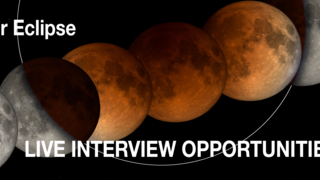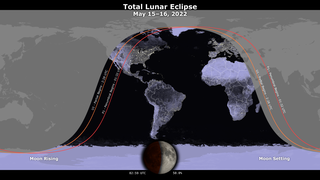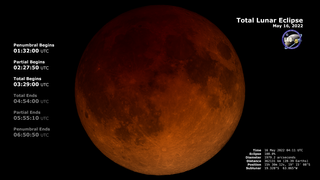Planets and Moons
ID: 4980
Both movies and high-resolution still images are available for Eastern (above), Central, Mountain, and Pacific Daylight Time, as well as UTC. Also see the visibility map and Dial-a-Moon for this eclipse.
On May 16, 2022 (the night of May 15 in the Western Hemisphere), the Moon enters the Earth's shadow, creating a total lunar eclipse, the first since May of 2021. This animation shows the changing appearance of the Moon as it travels into and out of the Earth's shadow, along with times at various stages.
The penumbra is the part of the Earth’s shadow where the Sun is only partially covered by the Earth. The umbra is where the Sun is completely hidden. The Moon's appearance isn't affected much by the penumbra. The real action begins when the Moon starts to disappear as it enters the umbra at about 10:28 p.m. EDT on the 15th. An hour later, entirely within the umbra, the Moon is a ghostly copper color. Totality lasts for an hour and a half before the Moon begins to emerge from the central shadow. Throughout the eclipse, the Moon is moving throught the constellation Libra.
May 15-16, 2022 Total Lunar Eclipse: Shadow View
On May 16, 2022 (the night of May 15 in the Western Hemisphere), the Moon enters the Earth's shadow, creating a total lunar eclipse, the first since May of 2021. This animation shows the changing appearance of the Moon as it travels into and out of the Earth's shadow, along with times at various stages.
The penumbra is the part of the Earth’s shadow where the Sun is only partially covered by the Earth. The umbra is where the Sun is completely hidden. The Moon's appearance isn't affected much by the penumbra. The real action begins when the Moon starts to disappear as it enters the umbra at about 10:28 p.m. EDT on the 15th. An hour later, entirely within the umbra, the Moon is a ghostly copper color. Totality lasts for an hour and a half before the Moon begins to emerge from the central shadow. Throughout the eclipse, the Moon is moving throught the constellation Libra.
Related
Visualization Credits
Ernie Wright (USRA): Lead Visualizer
Laurence Schuler (ADNET Systems, Inc.): Technical Support
Ian Jones (ADNET Systems, Inc.): Technical Support
Laurence Schuler (ADNET Systems, Inc.): Technical Support
Ian Jones (ADNET Systems, Inc.): Technical Support
Please give credit for this item to:
NASA's Scientific Visualization Studio
NASA's Scientific Visualization Studio
Short URL to share this page:
https://svs.gsfc.nasa.gov/4980
Mission:
LRO (Lunar Reconnaissance Orbiter)
Data Used:
Note: While we identify the data sets used in these visualizations, we do not store any further details nor the data sets themselves on our site.
This item is part of this series:
The Moon
Keywords:
SVS >> HDTV
SVS >> Lunar
SVS >> Moon
SVS >> Hyperwall
SVS >> LRO
SVS >> Lunar Reconnaissance Orbiter
SVS >> Eclipse
SVS >> Lunar Eclipse
NASA Science >> Planets and Moons
https://svs.gsfc.nasa.gov/4980
Mission:
LRO (Lunar Reconnaissance Orbiter)
Data Used:
LRO/LOLA/Digital Elevation Map also referred to as: DEM
JPL DE421 also referred to as: DE421
Ephemeris - NASA/JPL
Planetary ephemerides
Lunar Reconnaissance Orbiter/LRO Camera/Natural Color Hapke Normalized WAC Mosaic also referred to as: LROC WAC Color Mosaic
Mosaic - Arizona State University
This natural-color global mosaic is based on the 'Hapke normalized' mosaic from LRO's wide-angle camera. The data has been gamma corrected, white balanced, and range adjusted to more closely match human vision.
This item is part of this series:
The Moon
Keywords:
SVS >> HDTV
SVS >> Lunar
SVS >> Moon
SVS >> Hyperwall
SVS >> LRO
SVS >> Lunar Reconnaissance Orbiter
SVS >> Eclipse
SVS >> Lunar Eclipse
NASA Science >> Planets and Moons














